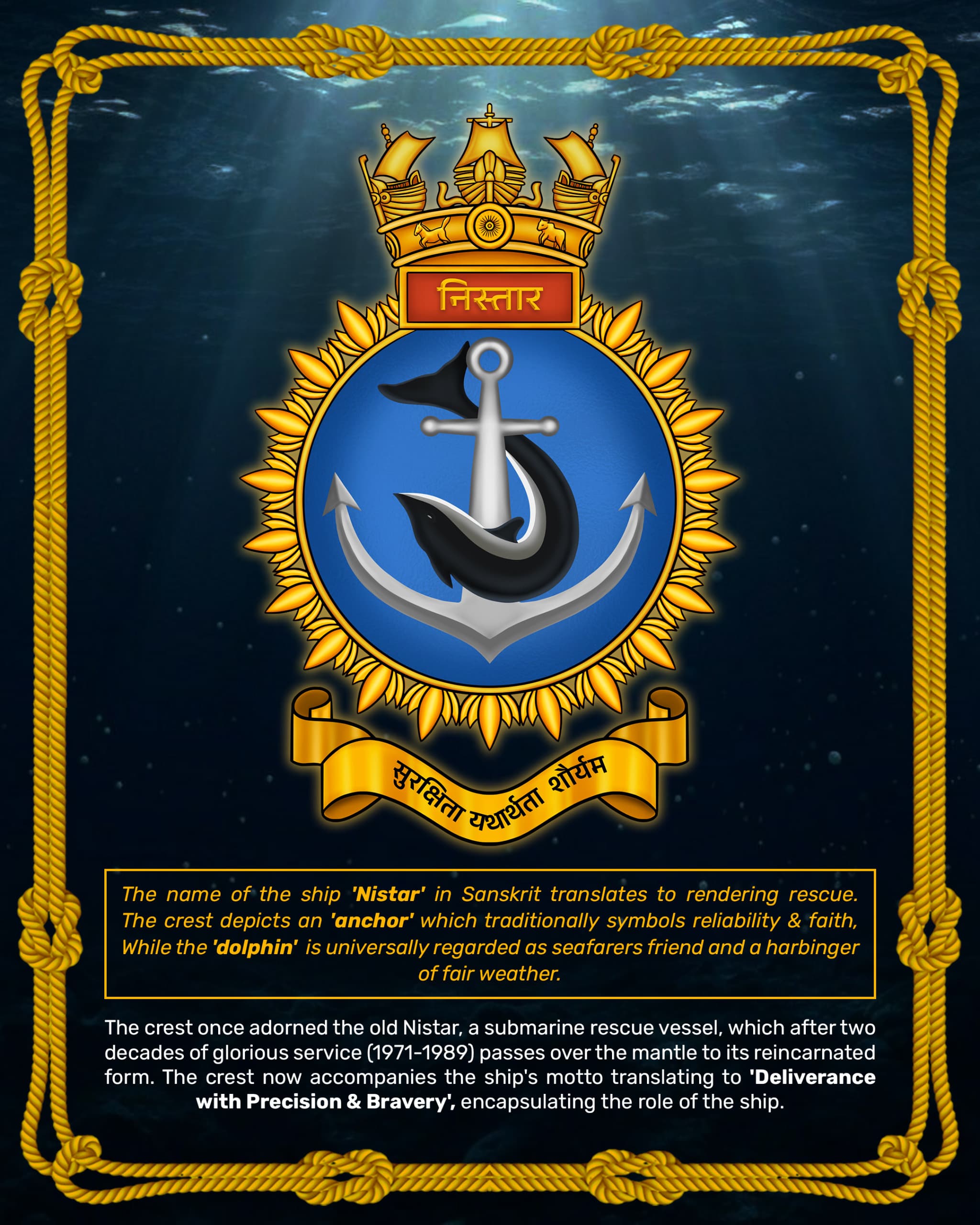New Delhi: The commissioning of INS Nistar on July 18signals that India has broken through one of the last technological glass ceilings separating emerging navies from established maritime powers.
Built in Visakhapatnam with more than 75% indigenous content and inputs from 120 MSMEs, the 10,000-ton vessel becomes the first purpose-designed Diving Support Vessel (DSV) in South Asia, instantly giving the Indian Navy an organic deep-sea rescue and salvage arm comparable to – and in some dimensions surpassing – the world’s benchmark systems.
Technically, Nistar combines a 118 m hull with a Dynamic Positioning System (DPS) that keeps station within a few metres even in rough seas, a saturation diving complex certified for 300 m operations, a side-dive stage for 75 m work, remotely operated vehicles (ROVs) able to conduct surveys or lift stores at 1,000 m, and an endurance of more than 60 days.
Acting as the “mother ship” for India’s two deep-submergence rescue vehicles (DSRVs), it can sail at short notice to any point in the Indian Ocean, embark stranded submariners, decompress them in a shipboard hospital that includes an operating theatre and an eight-bed ICU, and continue with heavy salvage if required.
Benchmarking these capabilities against the United States, NATO, and other advanced fleets shows that Nistar is firmly in the top tier.
The US Navy’s Submarine Rescue Diving and Recompression System (SRDRS) can dive to 2,000 ft / 610 m and rescue sixteen submariners per trip, but it must be air-lifted and bolted onto a “vessel of opportunity” that may not have medical or diving facilities of its own.
The NATO Submarine Rescue System (NSRS), jointly owned by the United Kingdom, France and Norway, shares the same depth rating and similarly relies on roll-on equipment that must be welded to a chartered ship before sailing.
By contrast, India’s approach folds diving, rescue, decompression and command spaces into a single hull, eliminating hours of deck welding, crane-rigging and calibration, a critical gain when every minute inside a disabled submarine counts.
Among Asian powers, the comparison is equally instructive. China’s Type 926 rescue ships also carry a DSRV certified for 300 m and can lift eighteen men at a time, yet they displace roughly 9,500 t with less extensive onboard medical facilities and still require LR-7 submarines bought from the United Kingdom for deeper work.
Japan’s new JS Chiyoda supports a 300 m DSRV and can treat sixteen rescuees per trip, but at 5,600 t it sacrifices endurance. Singapore’s MV Swift Rescue – often cited as the region’s best civilian-crewed rescue ship – must launch its DSAR-6 submersible by crane and tops out at 500 m, with a smaller hull of 4,300 t and a single ten-bed medical unit.
The Indian vessel therefore combines the endurance and deck-integrated layout of Chinese and Japanese ships with larger hospital capacity and deeper unmanned reach than most regional counterparts.
Nistar also closes a painful capability gap first highlighted by the tragedy aboard INS Sindhurakshak in 2013 when improvised diving teams struggled to reach entombed submariners inside the harbour itself. Those incidents spurred the Navy to procure two DSRVs in 2018 and to inaugurate dedicated rescue complexes on both coasts, but until now these submersibles lacked a bespoke platform, limiting rapid deployment in the far reaches of the Bay of Bengal or Arabian Sea.
With Nistar permanently assigned to Eastern Naval Command (ENC) and her sister-ship INS Nipun to follow, India can station one DSV on each seaboard, providing true two-ocean cover for its growing diesel-electric and nuclear submarine fleet.
The strategic dividends ripple far beyond hardware. India has long portrayed itself as the “net security provider” in the Indian Ocean Region, and Nistar offers a tangible service – life-saving submarine rescue – that even technologically advanced partners may lack when operating thousands of nautical miles from home bases.
Memorandum of understanding already allow Indian DSRVs to assist navies such as Singapore and South Africa; the presence of a fully equipped hospital ship enhances that offer and burnishes New Delhi’s SAGAR (Security and Growth for All in the Region) doctrine. Soft power aside, the capacity to clear channels, survey wrecks and place divers on subsea infrastructure strengthens deterrence against grey-zone sabotage of under-sea cables or energy lines crucial to regional trade.
Equally significant is what Nistar says about India’s industrial depth. Hindustan Shipyard Limited (HSL) progressed from cutting first steel to sea trials despite pandemic-era disruptions, integrating high-pressure diving bells, recompression chambers, ROV hangars and aviation fuel systems wholly in-house.
The result is a sovereign supply chain for spares and future mid-life upgrades, insulating the Navy from foreign embargoes that once hampered fleet sustainment.
INS Nistar elevates India from a nation that request foreign help in underwater emergencies to a provider of globally competitive rescue and salvage services.
Its integrated design outpaces modular systems in speed of response, its diving envelope matches or exceeds those of peer competitors, and its indigenous pedigree aligns neatly with the government’s Aatmanirbhar Bharat vision.
By safeguarding submariners and offering a regional public good, Nistar cements India’s status as the Indian Ocean’s resident naval power and positions the fleet shoulder-to-shoulder with the world’s most capable maritime forces.
You may also like

Billy Joel, 76, shares major health update after being diagnosed with brain condition

Mum made desperate 999 call for help - months before she and daughter found dead

Thousands gather to pay respects to Marxist veteran V S Achuthanandan

Urgent Alert for Investors: Post Office May Freeze Your Account if You Ignore This Step After Maturity

Delhi CM Rekha Gupta orders weeding out of ineligible beneficiaries of govt schemes







